I can remember my grandma and her cooking from decades ago, as if it were cooking on her stove right now.
I can also remember my grandfather who was a butcher by trade. So, he had access to some of the best meats and took advantage of that perk. But, not only did he grab the goods, he often also cooked it up for us when gathering as a family.
One of our all-time favorite dishes my grandma made was called “Slop”. I’m not even sure if she had a recipe, but I certainly haven’t been able to find anything like it since then. It was tender chunks of beef, carrots, celery, and onion with a thick and hearty gravy. Sounds like stew, right? I’ve had stew. This was different, and I’m not sure why, because she never left a recipe for it.
She put a pile of mashed potatoes or rice on the plate and slopped a scoop of her “Slop” over it. We always asked her to make extra so we could take it home and eat it for the next few days. Not because we had to, but because it was that good. She’s long been gone. So, I can’t ask her for the recipe anymore. And unfortunately, I was too young to realize that I would desperately want it someday.
But, that got me thinking. Many of us probably have recipes from grandparents that we would love to have right now. And, many of those recipes were most likely created during wartime and the Great Depression as a necessity for batches to last for a week or so. Some people might call that leftovers. But, not everything is good for a week’s worth of meals.
So, I looked into what recipes might have been passed down from our ancestors and that era, to compile them for an article to share. Not just for nostalgic reasons, but just in case SHTF.
Staples to Have on Hand
It’s not just about making meals that will last throughout the week during bad times. But, having a variety of ingredients on the shelf is also important, either to make these recipes or as a side for your favorite recipes.
Here is a good list of pantry items to consider, and how long each should last:
- Canned Fruit, Veggies, and Beans (up to 6 years)
- Canned Meat or Tuna (up to 5 years)
- Dried Fruit (approximately 1 year)
- Dried Beans (indefinitely)
- Corn Starch (indefinitely)
- Dried Pasta (about 3 years)
- Grains (about 8 years)
- Oats (2 years)
- Rice (30 years)
- Instant Coffee (about 25 years)
- Jams and Jellies (2 years unopened, 6 months opened)
- Jerky (2 years, sealed)
- Maple Syrup (indefinitely, unopened)
- Raw Honey (indefinitely)
- Sugar (indefinitely)
- Vanilla Extract (indefinitely)
- Oils (2 years)
- Powdered Milk (20 years)
- Ramen Noodles (2 years)
- Salt (indefinitely)
- Bouillon (2 years)
- Soy Sauce (indefinitely, unopened)
- Whole Spices and Herbs (up to 4 years)
- Tomato Sauce Can or Jar (2 years)
- Vinegar (Indefinitely)
Of course, the length of time listed above could vary, depending on how it’s stored. Cool and dry places, and airtight containers will lengthen the shelf life of many products.
So, let’s take a look at some tried and true recipes from our ancestors. It’s a list compiled of a few recipes that will last a week, some that will last several months, and a handful that use scraps so nothing goes to waste.
Long Lasting Recipes for when SHTF
Here are 30 recipes that I found, which will help you get through the hard times. Please keep in mind, with the exception of one, these are not my recipes. And, they are not fancy. But, most of them also don’t require hard to obtain and expensive ingredients either.
Some of them you can eat for a week, while others you can store for months…maybe even years. Below you will find the recipes and/or links to them.
Breads, Grains, and other Carbs
There are a lot of recipes for breads or crackers, and the use of grains. Some are good for longtime storage, while others are a good source of food for a week or so, depending on how many you make, and how you store them.
Nothing Fancy Wartime Loaf
Nothing like a fresh loaf of bread to help with a meal. It can be used for any meal, such as toast at breakfast, sandwiches for lunch, or a side for dinner. A loaf or two could last a week, depending on how many are eating, as well as how many meals it’s used.
This recipe makes 2 large loaves or 4 small.
Bannock
Bannock was created in both North America and Europe. Native Americans made something similar, only using corn.
The version in the link is more like a bread than hardtack, but also somewhat similar with the ingredients.
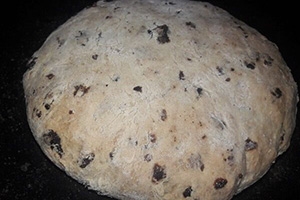
The shelf life discussed is for the mix, not the baked product. A basic bannock recipe, without a lot of additions, could last a couple months if you store it in a sealed baggie. If you don’t add the oil until you are ready to make it, then the shelf life is even longer. But, once it’s baked it should be used within a week.
Hardtack
Hardtack is a hard biscuit or bread that has a very long shelf life, decades long. Even though it’s typically on the bland side, soldiers would often eat these to fight off hunger. To add flavor, they can be dipped in broths and soups, or beverages.
When they are completely cooled, you can put them in an airtight container, then store in a cool and dry space. If stored properly, they should keep for decades.
Milkorno
 Milkorno was invented by scientists from Cornell University to help feed the masses during the Great Depression. It’s a mix of:
Milkorno was invented by scientists from Cornell University to help feed the masses during the Great Depression. It’s a mix of:
- 2 parts cornmeal
- 1 part powdered milk
- water
This could be used as a base for other recipes, or as a porridge or polenta on their own.
More breads and carbs:
- Leek Potato Pancakes
- Grandma’s Onion Squares
- Depression Era Macaroni and Cheese
Dried Meats, Beans, and other Proteins
There are several recipes for dried meat options, bean dishes, and other proteins to consider. They are often packed with protein and can be stored for a long time.
Jerky
Jerky from a store is often filled with unnecessary and unwanted preservatives. Whereas if you make it at home, you can create a high protein survival food that can last on the shelf for months.
Related: The 10-Dollar Jerky Maker
Biltong
 Similar to jerky, biltong consists of marinated and dried meat.
Similar to jerky, biltong consists of marinated and dried meat.
However, biltong is cured with vinegar and spices. It’s also air-dried, so you can make it anywhere.
With a shelf life of at least 5 years, it’s a great staple to have on hand.
Pemmican
Pemmican was created by Native Americans, and has been referred to as the ultimate survival food.
The reason is that it’s packed with protein and will last for decades as long as it’s stored in a cool dry place, such as a refrigerator or root cellar.
Lemon Garlic Lima Beans
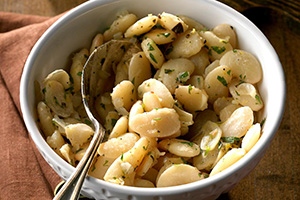 Lima beans might not be everyone’s favorite, but they can make a great dish that is adaptable, like the linked recipe.
Lima beans might not be everyone’s favorite, but they can make a great dish that is adaptable, like the linked recipe.
Add your own ingredients that you feel will add the flavor you prefer in a hearty side dish.
Or, add meat to make it a very filling main dish, one that could last for a few days if you make a big enough batch.
Creamed Chipped Beef on Toast
This is something I used to eat as a kid, and kinda liked it.
It’s easy, inexpensive to make, and can be made in large batches to last about a week.
Great Depression Casserole
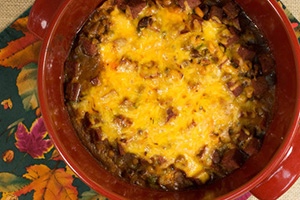 Using a few ingredients probably sitting in your pantry, this casserole was a good one to make in the Great Depression…inexpensive, easy, hearty, and enough for a week for a small family or individual.
Using a few ingredients probably sitting in your pantry, this casserole was a good one to make in the Great Depression…inexpensive, easy, hearty, and enough for a week for a small family or individual.
Related: Your Great Depression Era Recipe for Hard Times
Hoover Stew
This stew was created during the Great Depression and named after President Hoover who was in office at the time. Made with inexpensive ingredients, it’s a filling meal, and enough for leftovers for the week.
High-Calorie Ration Bars
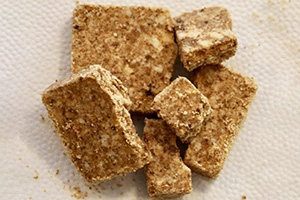 These bars are very high in calories, making a great option for a meal replacement.
These bars are very high in calories, making a great option for a meal replacement.
They will last a few months on the shelf if stored properly, and actually taste really good.
Related: How To Make Survival Ration Bars At Home
Corned Beef Salad
Using inexpensive ingredients, many out of your pantry, this dish is a popular item during the Great Depression. If kept refrigerated, it could last the week.
Depression Era Meatloaf
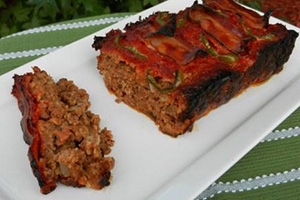 If you like meatloaf, you know it’s good on the first night, as well as leftovers such as sandwiches.
If you like meatloaf, you know it’s good on the first night, as well as leftovers such as sandwiches.
So, make 2 loaves and you can eat from it all week.
Make a sandwich, or cut it up to mix with rice or noodles.
Meatless Meatloaf
If you don’t have access to meat, or prefer to not use meat due to spoiling quicker, this meatless meatloaf recipe is a good option.
Jams
Jams are a great addition to a pantry. They don’t have to be refrigerated, until they are opened. And, they provide a nice variety to a person’s intake.
While they can sit on your shelf for years before opening, homemade jams should be used within a couple weeks after opening.
Rhubarb and Apple Jam
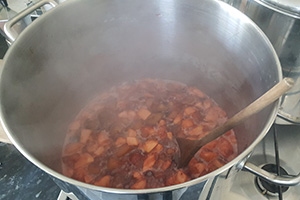 Jams are something that might be time consuming to make, but could last years on the shelf if canned properly.
Jams are something that might be time consuming to make, but could last years on the shelf if canned properly.
This jam will allow you to have a treat with a slice of bread or cracker either as a snack, or just to add a variety to a meal with something sweet and tangy.
This recipe makes several 10 ounce jars.
Summer Berry Jam
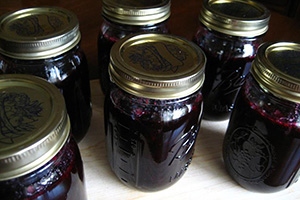 This is a good, and easy recipe for jam using your favorite summer berries. If canned properly, it can yield 4 good size jars and will last a couple years on the shelf.
This is a good, and easy recipe for jam using your favorite summer berries. If canned properly, it can yield 4 good size jars and will last a couple years on the shelf.
The butter you add acts as an additional sealant and can be removed when you open the jar for use.
Soups
Soups are my favorite food item, ever. It can be a very hearty meal, a light side, or just a good dish to warm you up on a cold night. They can also last a week, if you make a big batch.
Another big perk of soups is that they can often be made from items either in your pantry, or from leftovers.
If you have considered canning soups, here a few important guidelines:
- Soups need to be pressure canned.
- Do not add rice, noodles, flour, any milk product, cream, or thickeners (they can be added after you open a jar and heat it to serve or eat).
- Cook beans and peas before canning.
Make sure all ingredients are safe to can, for example cabbage has not been proven safe for canning. But, since sauerkraut is pickled, that would be fine.
Split Pea Soup
I always have ham left after making a ham dinner. And, I always have requests to make split pea soup with the leftover ham. My mother and grandmothers always used to make a good split pea soup. But, here’s my easy, but tasty recipe:
- 1 bag of split peas
- Ham bone
- 1 cup onion, diced
- 1 cup celery, diced
- ½ cup carrots, diced
- 1 large potato
- 2 cups ham, diced
- 4 cups chicken broth, homemade or canned
- 2 teaspoons black pepper, or to taste
Clean the peas by rinsing them and removing any outer skin that might come off. Place all the ingredients into a crockpot, with the exception of the diced ham. I typically hold off on adding the ham, just so it doesn’t overcook. No worries, the ham bone will add a ton of ham flavor.

Cook on high for a couple hours, then turn down to low for about 4-6 hours more. Stir the mix a few times throughout the day.
When you start to see the peas break down, add the diced ham. Stir good, and it should be ready within an hour.
After the leftover sets and cools, it thickens quite a bit. I typically add water to what’s left before reheating it.
Vegetable Soup
Vegetable soup is probably the most easily adaptable soup around. You can add or omit any vegetables you want, without ruining a recipe. Do you have any leftover veggies? Add those. You could also make a large batch, and add some meat to it later in the week to add variety.
Another option you have is using fresh or frozen. Fresh, in my opinion, always tastes better. But, in some areas, seasons, or situations, you might not have a good selection of fresh. And, since there isn’t any meat or cream in the recipe above, it will last about a week if refrigerated.
Lentil Soup
Lentil soup has been around for ages, for a good reason.
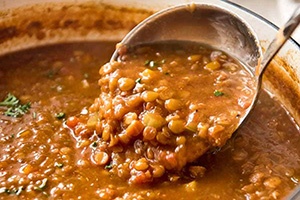
This recipe contains about 50% of your daily fiber needs, and 30% of protein in just one serving. And, it’s quite inexpensive to make, at around $2 for a batch which makes 4 large servings. If you want more servings to either feed a larger group, or have throughout the week, double the batch.
It’s still really cheap to make!
Depression Era Potato Soup
The great thing about a good basic potato soup recipe is all the options to add ingredients to change it up. Straight up potato soup one day, add a little bacon, sour cream, and chives for a twiced-baked potato soup the next. It’s hearty, inexpensive, and really good on a cold night.
Other Soups to take a look at that will last at least a week in the refrigerator, or months in the freezer:
- Carrot Chowder
- Great Depression Egg Drop Soup
- Tomato Soup
Sweets
Either to have at the end of a meal, or a snack, sweet treats have also been around forever with some great recipes handed down.
Bread Pudding
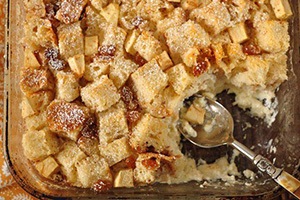 Bread pudding is a treat that has been around since the 13th century. And, the nice thing about bread pudding is that it’s highly adaptable…and filling.
Bread pudding is a treat that has been around since the 13th century. And, the nice thing about bread pudding is that it’s highly adaptable…and filling.
Using old bread and few other ingredients, it’s also inexpensive to make, even though it can taste like it’s a gourmet treat.
The recipe in the link uses challah bread, which tends to be sweeter than some breads. But, you could use any bread. In fact, why not try a savory bread, with savory seasonings for more of a main course or side dish, rather than a sweet treat?
Wacky Cake
They say this cake got its name because the thought of making a cake years ago without eggs seemed a bit wacky. This sweet treat could easily last about a week, depending on the portion size you choose.
Mock Apple Pie
Nothing like a yummy apple pie. But in hard times, the ingredients and cost could be an issue. So, why not try a mock apple pie? Depending on your portion sizes and how many people are eating it, it could easily last all week.
You may also like:
177 Cool DIY Projects for Preppers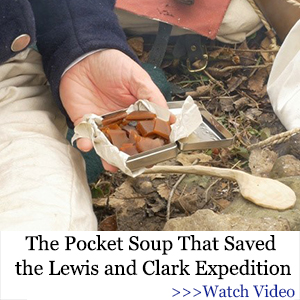
4 Lost Survival Lessons From The Heroes Who Tamed The Great Depression (Video)
This Tree Is Like Bread But You Can Only Harvest It In The Next 3 Months

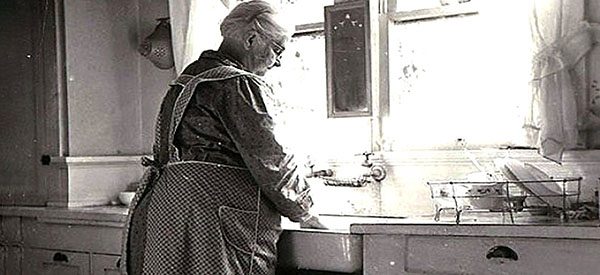














Her food was like no other. If it wasn’t for her or them, some times we would have starved. You brought back some good old memorys. They were the only ones that cared about us kids.
Thank you great grand parents you were the best.
She made bread and butter pickles. My most favorite. Out of this world. Sure would like to have a jar or two.
You know it might have been hard back then and way less to have, but it was way better times then today…
I know she was a prepper like no other, know that I set and think about it. Small farm and a garden that would grow anything she planted.
I new that I wanted to be just like them. So I have been prepping sences I was just big enough to go and help them. I’m sure if we could think back to the good old days. You were being trained to survive. I saw her grab a chicken one time. She pop off its head right in front of me and she showed me how to pluck the feathers with a pale of hot water and gut and butcher it and yes that night we had the best fried chichen you have tasted. My wife will not eat a chicken that I have killed. So don’t name them. Lol.
Me I’m good have no problem eating them. I say names just makes them taste better.
Her heart was full of love and her life showed it. Sad to lose her..
My great grandpaw he lived to be 110 and 7 months. From 1890 to 2001. Spent some dam good times with him. He was a butcher. Thought me a lot, Dam I miss them. ? They would crap to see things know. ?
Thank you GOD for them…
Have fun one with this one. Your eyes will tear up and you heart will fludder and the memorys will flood your mind…
soup we had as kids – called it “bally soup” – was a pea soup with dough chunks – just irregular chunks formed by spooning a dough hunk into the hot water >> didn’t have any meat but eazily have some pork in it ….
IIIini Warrior – Cookbooks will refer to those chunks of dough as dropped dumplings.
While in the Navy 69-72 our home port was Subic Bay the Philippines. I visited a cafe there, that introduced me to Pancit. The people called it Filipino spaghetti, but it was basically a garbage plate. Any available meats, (diced into bite size chunks) any available vegetables, (diced into bite sized chunks) simmered in a thick brown gravy … then poured over ramen style or any type of oriental noodle. Top with a squeeze of lime juice, a sprinkle of soy sauce, and you were in heaven. I taught my mother how to make it, and she as everyone … has their own take on making it … hers was wonderful … and thankfully, she wrote down her recipe. It was vague, but I tried it recently, and from the first bite, I was back in that cafe on Olongapo Blvd in Subic Bay ….
Used some of these for Elk camp and high ground goat. Grew up eating these as a young one. Still eat them today nothing compares to real SOUL FOOD
I love soups of all kind. They’re nutritious, and filling, and not too expensive. My grandmother made a vegetable soup that had a little of everything in it. It was so good. She’d use all fresh veggies in season, prepare them and put in a huge metal dish pan. She’d heat them up till almost done. Then she’d put them in freezer bags, and freeze. It was the best soup ever! She also froze corn and beans and peas and all other veggies. Her and granddaddy would go pick their own, and put it up.
Wish there was more recipes or links to the recipes.
Guess you have to look for the actual recipes elsewhere….
I just posted a comment with the links to the recipes (that were not typed out in the article). I apologize that my original links didn’t work. Here is the list:
Here are the links to all the recipes (that are not typed out in the article):
Nothing Fancy Wartime Loaf:
https://the1940sexperiment.com/2009/08/08/return-to-the-1940s-wartime-loaf/
Hardtack:
https://www.askaprepper.com/hardtack-biscuits-100-year-shelf-life/
Bannock:
https://www.survivopedia.com/how-to-make-bannock-for-survival/
Leek Potato Pancakes:
https://www.tasteofhome.com/recipes/leek-potato-pancakes/
Grandma’s Onion Squares:
https://www.tasteofhome.com/recipes/grandma-s-onion-squares/
Depression Era Mac N Cheese:
https://www.providencejournal.com/article/20140507/Lifestyle/305079911
Jerky:
https://www.offthegridnews.com/extreme-survival/how-to-turn-old-meat-into-survival-jerky-that-lasts-months-and-months/
Biltong:
https://prepperswill.com/how-to-make-biltong-with-a-5-year-shelf-life-more/
Pemmican:
https://www.askaprepper.com/pemmican-ultimate-survival-food/
Lemon Garlic Lima Beans:
https://www.tasteofhome.com/recipes/lemon-garlic-lima-beans/
Great Depression Casserole:
https://www.recipelion.com/Budget-Friendly-Recipes/Great-Depression-Casserole
Hoover Stew:
https://www.recipezazz.com/recipe/hoovers-stew-30152
High Calorie Ration Bars:
https://www.askaprepper.com/how-to-make-survival-ration-bars-at-home/
Creamed Chipped Beef on Toast:
https://www.allrecipes.com/recipe/20225/creamed-chipped-beef-on-toast/
Depression Era Meatloaf:
https://www.tasteofhome.com/recipes/depression-meat-loaf/
Meatless Meatloaf:
https://www.food.com/recipe/really-good-vegetarian-meatloaf-really-33921
Corned Beef Salad:
https://www.cooks.com/recipe/sn19w5ou/corned-beef-luncheon-salad.html
Rhubarb and Apple Jam:
https://the1940sexperiment.com/2020/05/02/rhubarb-apple-jam-recipe-no-193/
Summer Berry Jam:
https://the1940sexperiment.com/2013/08/13/summer-berry-jam-recipe-no-115/
Vegetable Soup:
https://the1940sexperiment.com/2015/01/18/vegetable-soup-recipe-no-139/
Lentil Soup:
https://the1940sexperiment.com/2012/10/01/lentil-soup-no-95/
Depression Era Potato Soup:
https://diyjoy.com/depression-era-potato-soup-recipe/
Carrot Chowder:
https://www.tasteofhome.com/recipes/carrot-chowder/
Great Depression Egg Drop Soup:
https://ardelles.com/great-depression-egg-drop-soup/
Tomato Soup:
https://www.tasteofhome.com/recipes/quick-tomato-soup/
Bread Pudding:
https://www.recipesjunkie.com/grandmas-bread-pudding-recipe/
Wacky Cake:
https://www.thespruceeats.com/wacky-cake-3053338
Mock Apple Pie:
https://www.snackworks.com/recipe/ritz-mock-apple-pie-83403.aspx
KJBarber.
Your first post was awesome. Thank you.
Loved this article best of all. It made me think of the loved ones that cared so much back in the good old days.
Now they really new how to survive back then…
Thank you for coming back and giving us all the recipes.
Happy cooking…
Thank you Red Ant. I really enjoyed the trip down memory lane. Our grandparents had so much to offer us!
I grew up during WWII, so it was my mother who prepared the food, not my grandmother. We lived in a small town outside Philadelphia about a quarter mile from the main Pennsylvania RR line between New York and Washington D.C.
By today’s standards, we had a huge yard. The house we lived in was close to 100 years old by the time my parents bought it. That was when interior walls were genuine lath and plaster. A 2×4 was actually 2 inches by 4 inches, not 1 3/4 by 3 3/4. The house was three stories with a full basement and a root cellar. The coal furnace was in the basement together with the bucket-a-day water heating stove and the hot water tank. There was a well under the house, but the water table had dropped and there was never more than 3-4 inches of water in the well. We used city water. We were also hooked up to the city sewer line. I am sure at one point in its life the lot had held an outdoor privy.
We had a Victory Garden during the war as did most of our neighbors.
We never ate most of the items listed in this article. But we did have lots of navy bean soup with a ham bone, split pea soup with ham bone, lentil of bread to expand the meatloaf, rice pudding with raisins, tapioca pudding, bread pudding with raisins and cinnamon, lots of canned fruit and apple sauce by the gallon, Jelllo and Junket, a pudding-like desert made with rennet. Candy only at Halloween during which I spent a lot of time collecting. Out immediately after supper and it was the one time of the year when I could stay out after the street lights came on. No parents every accompanied their child while out trick or treating. If you weren’t old enough to go by yourself, you weren’t old enough to be out at all.
We had margarine with the orange dye button which was kneaded into the margarine to make it look like butter. Ha ! Not much confusion there. The margarine in those days didn’t come close to “I can’t believe it’s not butter” by even the wildest stretch of the imagination. It was a variegated colored grease, not as tasty as bacon fat. I would much rather have a piece of bread soaked in hot bacon fat than a slice of bread slathered with WWII margarine. Now that would have made a good substitute for gun grease as it didn’t have the salt in it that bacon has.
Peanut butter and jelly was the preferred lunch sandwich. I was always partial to grape jelly as opposed to strawberry jam which most of the kids favored. Plain bologna was the standard lunch meat. Pimento loaf was an upgrade from bologna. My favorite lunch meat was Lebanon bologna now sold as summer sausage. Velveeta was the standard cheese. Swiss cheese was a delicacy enjoyed only occasionally. Lots of spareribs. My mother liked liver but didn’t know how to cook it as it was always as tough as shoe leather the way she cooked it. When my father splurged on himself he would buy a jar of pickled pigs feet which he enjoyed immensely and got to eat the whole jar himself because nobody else ate them. Lots of stewing chicken. Fried chicken was not that common in our house we had stewing chicken as chicken a la king, creamed chicken on rice or mashed potatoes and my mother’s version of chicken chop suey. We had a lot of beef stew with some very economical cuts of beef when it was available at the meat market. Beef was rationed. I don’t recall if pork or chicken was rationed. Early in WWII my mother ground her own hamburger. She had a hand meat grinder and she would use that to grind up meat for hamburgers and meat loaf. My guess today was that the hamburger sold as hamburger had just too much fat in it for my father’s taste. Having hamburgers on buns was a summertime treat and didn’t occur too often. We had lots of hot dogs in various manners. My least favorite was boiled hot dogs. Hot dogs cut up into beanie weenies was a favorite as was hot dogs and sauerkraut. We ate a lot of scrapple which is a Pennsylvania dish. Fried scrapple and eggs for breakfast was a real rib sticking meal to start the day, especially in the winter. We did have chipped beef creamed and on toast, rice or mashed potatoes. Chipped beef in those days was a cheap meat. No so today. They are still using that little jar but the price is considerably higher than it must have been if we were eating a lot of it.
My mother canned most of the vegetables we raised in the yard so we had a lot of home canned veggies. I can only remember dining in a restaurant two times until I was in high school and had my own earnings. Once at Horn & Hardart’s Automat in Manhattan when we had seen the Rockettes and once coming back from watching the Mummer’s Parade on New Years Day we stopped at White Castle and had their hamburgers.
Probably the healthy meals I ate as a child are the reason I am still hanging around at this advanced age. Healthy meals together with lots of outdoor exercise — you know, “Go outside and play. Be home by dark.” It wasn’t dark until the street lights came on. We were too busy playing war, throwing dirt grenades at each other and if we didn’t have a toy gun, making do with sticks. Despite all that blood and guts, I don’t remember a single student ever shooting up his school even though guns were not locked up. If you were rural enough there was a loaded shotgun behind the kitchen door and dad’s rifles were hung in an open wooden rack either in the den or perhaps even in the living room.
I am of the opinion that even with fantastic medical advances, we won’t see any generations living as long on average as the Greatest Generation due to their healthy life styles in early life and the significant medical advances made as a result of WWII and subsequent wars, especially in trauma medicine.
When I was growing up unless you lived in a major city there was no ambulance service. You tried to get a neighbor who had a car to haul you to the hospital and if someone had a telephone, because not everyone had a telephone in their house, you called a doctor’s office, sometimes The Doctor as there was only one in town, and he would meet the patient at the hospital. Otherwise the doctor wasn’t called until after you arrived at the hospital. If you were lucky, there was a doctor in the hospital visiting some of his patients and he would be called to the operating room to treat the emergency patient. If you were in with a compound fracture of the leg your initial doctor might be a gynecologist who hadn’t set a leg since his residency. If it was a traffic collision and the state troopers responded they threw you in the back of their patrol car and took you to the hospital.
Boy scout first aid was todays basic EMT training. I learned to do many “first aid” items that are only taught in basic ET training or advanced EMT training. Every boy scout with a first aid merit badge knew how to set a broken bone, including compound fractures although the advice was if at all possible get the victim to a hospital, otherwise go ahead and set it, making sure to clean the wound thoroughly.
If there were no motor vehicle immediately available you would hail a passing motorist and they most generally would haul you to the hospital. Folks were more apt to stop when somebody was waving at them from the side of the road in those days. Servicemen hitchhiked home on leave and everybody picked up a serviceman by the side of the road in uniform with a seabag beside him. Often times the motorist would take the serviceman directly to his destination if it were not too far. Different times from today by far.
By today’s standards almost everyone who lived outside a major city was a prepper.
Chuck, you are awesome! Thank you for your post. I’m a 1951 model. I lived some of your experiences. It was a better time to be a child then. Not so these days.
I was wondering as to, Why You don’t have ALL Your articles in .pdf format? I Am sure I would appreciate that, as I Am sure so would ALL Your other readers. To the contrary would be a ‘Disservice’ to ALL Your customers and clients!
I have bought just about every book You sell.
A visit to grandmas house ment wonderful fried chicken and tons of fresh vegetables from her big garden. Her neighbor made a French style beef stew that was a served over mashed potatoes. She would always bring some over when we were visiting.
I loved the shower just outside the back door. A quick shower then bedtime. Grandma used it if she got dirty or muddy from working outside. I loved it to cool off. We lived in hot, dry, southern California. She lived in hot sticky Florida.
Grandma hated alcohol but coughsyrup at her house was a pint of whiskey with a few sticks of rock candy dropped in. If you were running a fever yiu got an aspirin and a shotglass of her cough syrup. For a cough you got a tablespoon full.
She also made a gallon of dandelion wine each year. She never drank it as wine. It was the base for her lemonade. She disolved the sugar in the wine then added lemon juice and lemon slices and add water to taste. It gave her lemonade a pretty pale yellow color and tasted wonderful. Today we’d call that a wine cooler. I’d help gather dandelion flowers for the next batch of wine. It took a lot of flowers!
Great memories. Mom made a lot of the things mentioned in the article. She knew gourmet cooking but we forraged for wild greens and her macaroni and cheese was a rich with milk, cheese, and eggs. Baking it till the top was a light golden brown gave it an even richer flavor.
Great memories. My grandmother and both parents were adults though the depression and WWII. Those hard times shaped how they lived afterwards. Gardening, canning, drying fruits and vegetables, even forraging were a way of Iife. We were never completely out of food. There were some lean times. In those days we could still glean fruit orchards or buy seconds from farmers. Supper might be toasted home made bread and lightly sweetened, thickened home canned fruit but we ate. Sometimes mom bought a flat of pullet eggs from the farmer we regularky bought eggs from. Small but still good eating. I was learning to cook. I’d proudly cook two of those little eggs for my breakfast.
Today would have been Dads birthday. Tomorrow is mine. We always shared a cake. One year his favorite cake, yellow cake with chocolate frosting. The next year my favorite cake, white cake with 7 minute frosting and lots of shredded coconut.
Thanks for the walk down memory lane.
Alas, few links. I’d be interested in such things as the Great Depression Casserole or the meatloaf.
My wife would love more soup recipes (she made a split pea and lentil soup last week that knocked my socks off).
For depression era meatloaf one adds bread in place of half the meat — or more bread and even less meat if times are really lean. Normal recipe, just substitute bread chopped up into cubes and then mixed into the meat and other ingredients until it is well mixed. It will absorb the fats and meat juices and almost resemble meat when cooked.
Bread has always been relatively cheap in this country. If I recall correctly, it was still only 17¢ a loaf at the grocery store where I worked in 1959.
I still use bread (sometimes Italian bread crumbs) in my meatloaf, along with lots of veggies.
thanks for the memories! unfortunately like you, I didnt get hardly any recipes from my grandmothers. my nanny mad 2 great things I remember well…pot pie (was made with chicken or beef, and rolled out squares of dough and potatoes) (dutch), none of us generations have been able to duplicate it! my father’s mother’s was bread pudding, oh how I loved it, she made if for me when I had my tonsils out instead of ice cream. that I can make, but I never got any of her recipes. too bad..yep wonder what they would all think of today….all my folks are gone…..
Another big item my grandma made was her pies…especially lemon meringue. She would make them for local bakeries and they were the best. But, she never followed recipe, so there wasn’t one to pass down. We have tried to duplicate it, but somethings just can’t be.
your “mock apple pie”? was it made with ritz crackers? my mother’s was and I have the recipe, you cant tell the difference with the crackers!!! soooo good…….
Yes, it is made with Ritz!
In addition to lentil and split pea, there are some great soups that use other dry beans as a base, are quite economical, and seems to taste better the next day. Classic Garbure is one of them. A French Alpine soup based on ham hock, savoy cabbage and white beans with lots of added herbs and root vegetables. Fresh vegetables thrown in the pot too if they are available.
My grandma never made these during world war two. She was too much of a spoiled brat to even cook
I, too, have enjoyed and still make many of the recipes you and the other preppers have mentioned. I might add that we used to make and bottle our own root beer, and a friend of mine still makes her own ginger ale.Pancake syrup is easily made: 2 parts sugar to one part liquid, brought just to a boil so it won’t crystallize. I have used various fruit juices for my liquid, and when I use plain water, I add maple-flavoring (Mapeleine is best).
If you know the basics of cooking, you can come up with tasty meals using whatever it is you have on hand.
Ah, yes, home made root beer. We had a big crock and always saved our soft drink bottles. We only made root beer in the summer time because it needed to sit in the sun to make the yeast work. We would mix up a batch in the 5-gallon crock we had, pour it into bottles, cap the bottles with the capper we had and sit the bottles out in the sun, turning them a couple of time and bringing them into the seller through the outside entrance so that they didn’t get too chilled with evening dew. In the morning as soon as the sun was shining on the place were we placed the bottles, they went back out in the sun.
I don’t recall at this late date how long we left them sit in the sun. My recollection is that the sun activated the yeast and carbonated the sweet drink. Actually hot root beer is rather refreshing.
Root beer was my father’s favorite drink. He didn’t drink alcohol unless he had a cold, then it was a shot of Old Overholt, lemon juice, honey in a glass of hot water and to bed and sweat out the cold. We had that bottle as long as I remember up until the time I went in the Marine Corps. He didn’t touch the stuff otherwise and I guess didn’t get sick much either.
Left Coast Chuck’s comments are ALWAYS insightful and educational. I usually aim straight for his first. I’m from the 1957 production line so I too have lived some of those same recollections as it was my parents who were the WWII adults along with G’ma(s) & G’pa(s).
Love the knowledge, folk lore, music and tid-bits from that harder but simpler time. I’m a generation too young.
Thanks Chuck
Slop sounds like something Gramma thought up. Good cooks are good artists and quick on the brain.
When growing up, I had no idea were were poor till we moved to town. It was a huge change. Indoor plumbing! Ugly, country-hating neighbors. Life is like that. Play the cards you’re dealt. niio
Yes, it was definitely made up, but SO good!
Here are the links to all the recipes (that are not typed out in the article):
Nothing Fancy Wartime Loaf:
https://the1940sexperiment.com/2009/08/08/return-to-the-1940s-wartime-loaf/
Hardtack:
https://www.askaprepper.com/hardtack-biscuits-100-year-shelf-life/
Bannock:
https://www.survivopedia.com/how-to-make-bannock-for-survival/
Leek Potato Pancakes:
https://www.tasteofhome.com/recipes/leek-potato-pancakes/
Grandma’s Onion Squares:
https://www.tasteofhome.com/recipes/grandma-s-onion-squares/
Depression Era Mac N Cheese:
https://www.providencejournal.com/article/20140507/Lifestyle/305079911
Jerky:
https://www.offthegridnews.com/extreme-survival/how-to-turn-old-meat-into-survival-jerky-that-lasts-months-and-months/
Biltong:
https://prepperswill.com/how-to-make-biltong-with-a-5-year-shelf-life-more/
Pemmican:
https://www.askaprepper.com/pemmican-ultimate-survival-food/
Lemon Garlic Lima Beans:
https://www.tasteofhome.com/recipes/lemon-garlic-lima-beans/
Great Depression Casserole:
https://www.recipelion.com/Budget-Friendly-Recipes/Great-Depression-Casserole
Hoover Stew:
https://www.recipezazz.com/recipe/hoovers-stew-30152
High Calorie Ration Bars:
https://www.askaprepper.com/how-to-make-survival-ration-bars-at-home/
Creamed Chipped Beef on Toast:
https://www.allrecipes.com/recipe/20225/creamed-chipped-beef-on-toast/
Depression Era Meatloaf:
https://www.tasteofhome.com/recipes/depression-meat-loaf/
Meatless Meatloaf:
https://www.food.com/recipe/really-good-vegetarian-meatloaf-really-33921
Corned Beef Salad:
https://www.cooks.com/recipe/sn19w5ou/corned-beef-luncheon-salad.html
Rhubarb and Apple Jam:
https://the1940sexperiment.com/2020/05/02/rhubarb-apple-jam-recipe-no-193/
Summer Berry Jam:
https://the1940sexperiment.com/2013/08/13/summer-berry-jam-recipe-no-115/
Vegetable Soup:
https://the1940sexperiment.com/2015/01/18/vegetable-soup-recipe-no-139/
Lentil Soup:
https://the1940sexperiment.com/2012/10/01/lentil-soup-no-95/
Depression Era Potato Soup:
https://diyjoy.com/depression-era-potato-soup-recipe/
Carrot Chowder:
https://www.tasteofhome.com/recipes/carrot-chowder/
Great Depression Egg Drop Soup:
https://ardelles.com/great-depression-egg-drop-soup/
Tomato Soup:
https://www.tasteofhome.com/recipes/quick-tomato-soup/
Bread Pudding:
https://www.recipesjunkie.com/grandmas-bread-pudding-recipe/
Wacky Cake:
https://www.thespruceeats.com/wacky-cake-3053338
Mock Apple Pie:
https://www.snackworks.com/recipe/ritz-mock-apple-pie-83403.aspx
Thanks, KJ!
@KJBarber:
THANK you! It looked like there should have been links in the name of the ‘recipe’, but there weren’t
While this post is not about food, it is about life during WWII. On February 7, 1943, the federal government announced that rationing of leather shoes would go into effect on February 9, 1943. Each person was limited to 3 pair of leather shoes per year.
Suddenly it dawns on me why most kids I knew wore Keds if the family was well to do, or wore J.C. Penny or M. Ward or Sears sneakers if things were a little tighter. With Sonny wearing sneakers, that meant his ration of 3 leather shoes could be used by Mom or Dad. I think girls still wore leather shoes although at that age, I didn’t associate much with icky girls. An outlook that changed upon achieving a little more maturity. Be that as it may, every boy I know wore sneakers to school. They weren’t called athletic shoes and weren’t endorsed by big name sports figures. They were just plain old black canvas uppers and rubber soles, thus “sneakers”.
I was lucky I’m blessed with a good memory and still remember how my Mimi made a few of my favorite dishes. But I had an Aunt that made a fruit liqueur in a 5gallon crock that she bottled and gave as Christmas gifts so delicious. If anyone has a recipe for this I would appreciate it. All seasonal fruit with a amount of sugar and time. Anybody???